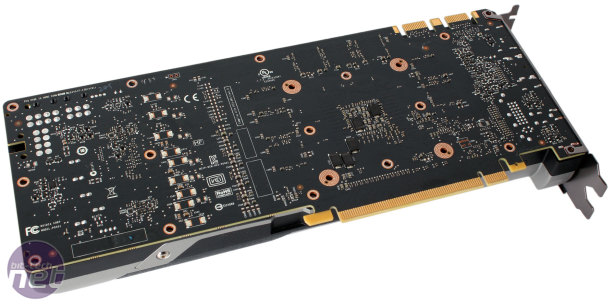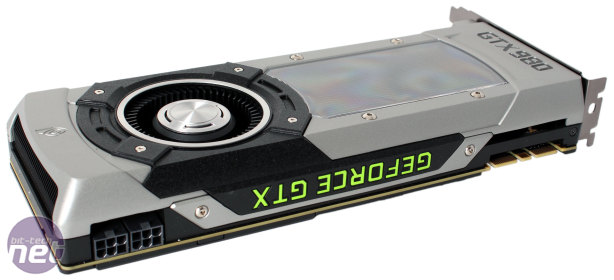
Performance Analysis
Overall, looking at the performance and power figures, the GTX 980 does indeed assert itself as both the fastest and most efficient GPU currently available.In Battlefield 4, the GTX 980 matches GTX Titan Black on the minimum frame rate (66fps) but trumps it on average at 1080p. Moving up to 1440p, however, sees the Titan Black and the GTX 780 Ti overtake the GTX 980 on the minimum frame rate. It's not a major difference, but it may well be due to the GTX 980's lower memory bandwidth; there's a particularly gruelling section of this benchmark where a character's face is very close to the player's viewpoint, and the texture and detail on it is very high at and above this resolution. It is the section where all cards dip to their minimum fps numbers, and it may be that the greater bandwidth on the two GK110 parts helps them stay slightly faster. However, at 4K, the GTX 980's 28fps minimum compares favourably to the 25fps of those two cards. The R9 290X and R9 290 also do well here with 28fps and 27fps respectively. As such, it seems likely that the combination of 64 ROPs and a 4GB of frame buffer are the crucial element for success at 4K here – only cards that match both criteria stay above 25fps.
In BioShock Infinite, it's a simpler story. The GTX 980 is the fastest single GPU card at every reoslution, where it is at least 30 percent ahead of the R9 290X. The GTX Titan Black manages to match its minimum frame rate of 35fps at 4K, but the GTX 980 still wins out on average.
Crysis 3 again gives pole position to the GTX 980 every time, and this time its minimum frame rate is never matched. This time, however, it isn't quite as fast compared to the R9 290X – its advantage sits somewhere between 17 and 19 percent at playable resolutions, which is still a significant margin.
Our final game, Skyrim, is of course no challenge for the GTX 980. It averages over 120fps at 1440p with all settings at full, and at 4K it's almost able to hit a constant 60fps, though it doesn't offer any performance advantage over the GTX 780 Ti or GTX Titan Black here, and its lead over the R9 290X is a meaningless 2fps.
The Unigine Valley 1080p result is mostly just so that most people can easily compare their own set-up to the results here. However, with a score of 4,890, the GTX 980 trumps both the R9 290X and the GTX 780 by a juicy 25 percent. Of course, you don't buy a card like this to play on a 1080p screen, so it's good that even at 1440p the GTX 980 is still the single GPU king, albeit only slightly, as it beats the GTX Titan Black and GTX 780 Ti by just 47 and 100 points respectively. Meanwhile, it has 23 percent and 28 percent leads on the GTX 780 and R9 290X respectively.
The power consumption figures are frankly phenomenal. The GTX 980 just manages to land itself on the right side of 300W (total system power consumption) under load, which makes it incredibly efficient compared to anything else on the chart (except the GTX 750 Ti). Its figure of 299W is more than 80W below that of the GTX 780 Ti and GTX Titan Black, both of which it manages to match or even beat in nearly every benchmark. Better yet, it is 110W less than the R9 290X, which is beats by up to 30 percent in some tests. Granted, even for hardcore gamers this difference isn't going to drastically alter your annual energy bill, but it's still not an insignificant difference. The two flagship cards couldn't be much further apart when it comes to performance per watt.
The thermal performance is exactly as expected. As with the GTX 780, GTX 780 Ti and GTX Titan Black, the GTX 980's fan only spins as fast as is needed to keep the card at 80°C, resulting in a delta T of around 60°C for all four. Again, this is lower then the R9 290 cards, which run at 95°C by default. The card's cooler under load is audible, but quiet, and there's no noticeable noise from the power components either.
The 18 percent core and 11 percent memory overclocks were certainly very pleasing. At 1440p, the new speeds were enough to boost performance by 17 percent in all three benchmarks (Battlefield 4, Crysis 3 and Unigine Valley). Also, despite the increased temperature limit, the core temperature only climbed by 2 or 3°C and though the fan had to work harder it wasn't by much – certainly not enough to make it loud or annoying. Our system power consumption did increase by 51W to 350W under load (remember we increased the card's power limit to 125 percent), but even this figure is still below the GTX 780 and well below the R9 290-series cards, both of which it utterly dominates when running at these frequencies.

MSI MPG Velox 100R Chassis Review
October 14 2021 | 15:04











Want to comment? Please log in.